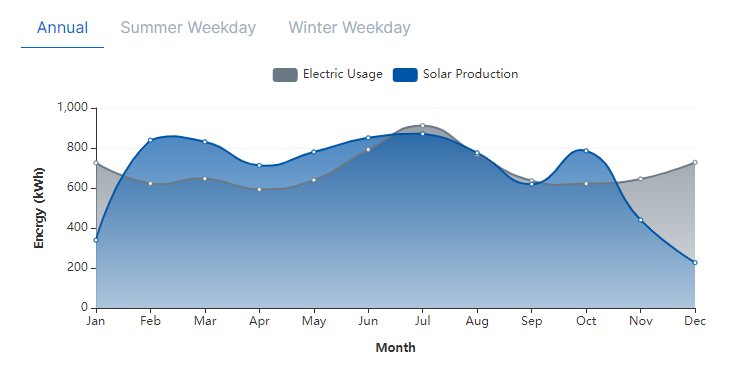Updated 1 year ago
Guide to Pennsylvania net metering in 2025
Written by
Ben Zientara

Find out what solar panels cost in your area
If you live in Pennsylvania and have or want a solar installation, net metering is one of the most important solar incentives to know about.
In a nutshell, net metering is the process of when homeowners are compensated by utility companies for sending them any excess energy their solar system generates that their home has not used. This compensation comes in the form of ‘credits’ that can be used towards their electric bill.
Net metering is a state-by-state policy. So, where you live can affect the value of your net metering credits. If you want to learn more about the net metering policy in Pennsylvania, keep reading.
Pennsylvania net metering at a glance
-
Net metering is the main way residential customers in Pennsylvania save money with solar panels.
-
Under net metering, all excess generation from your system is credited to your power bill, ensuring you will enjoy the full benefits of home solar power - electricity savings and clean, renewable energy.
-
All customers of Pennsylvania utilities can get net metering.
-
In addition to net metering, Pennsylvanians can take advantage of the federal solar tax credit, and can sell their Solar Renewable Energy Certificates (SRECs).
-
To get started with your solar journey, get quotes from multiple installation companies and compare the quotes to get the best deal.
Pennsylvania net metering details
In 2004, Governor Ed Rendell signed the Alternative Energy Portfolio Standards Act (AEPS) into law. When it was passed, the AEPS directed the Public Utilities Commission (PUC) to set rules requiring utility companies in Pennsylvania to obtain a certain amount of the energy they purchase from alternative energy sources (like solar) by a certain date.
The goal was for 18% of all energy sold to customers to come from compliant sources by 2021. That goal date has now passed, and the goal is no longer mandatory - but other parts of the AEPS live on.
One of the most important parts of the AEPS for Pennsylvania homeowners was net metering and interconnection rules. Basically, the AEPS contains rules for how “customer-generators” who own small renewable facilities (like home solar panels) can connect to the grid, and how their owners get paid for the clean energy they generate.
Lucky for us, the law requires all electric utilities (aka Energy Distribution Companies) in the state to purchase excess renewable energy from eligible system owners at the full-retail rate.
Who can participate in net metering in Pennsylvania?
Customers of all Pennsylvania utilities can get net metering. Investor-owned utilities like Penelec and Duquesne are covered, as are municipal utilities and member-owned cooperatives. If you are a customer of one of these utilities, you can get net metering.
On the other hand, if you use PA Power Switch to shop for electricity from an electric generation supplier (EGS), you might not be able to get net metering. Check with your EGS to see if they offer credit for solar energy, or switch back to the utility before installing solar so you can earn net metering credits.
This might seem confusing. Thankfully, local solar companies deal with the electric utilities all the time and can provide you with good advice on how to make sure you’re getting the best possible deal.
How net metering saves you money
Let’s say you’re a Pittsburgh resident with a south-facing roof and a $100/month bill from Duquesne Light. You’d need around a 7.4 kilowatt solar energy system for your home to make as much electricity as you use in a year. According to our solar calculator, the system would produce an estimated 786 kWh in October, and your home will likely use around 622 kWh.
That means you can bring your bill for October down to just the customer charge of $12.50 plus a few cents for taxes, and you’d also earn a credit for the remaining 164 kWh you generated and didn’t use (worth about $26 at the retail rate of $0.159/kWh).
The next month is November, and solar panels traditionally make less energy as the sun sets earlier and snow storms start to happen. Our calculator shows an expected electricity generation of 440 kWh versus usage of 645 kWh. That means your bill would have included a charge for 205 kWh, but Duquesne will apply your 164 kWh credit, bringing the net amount down to 41 kWh, or $6.52.
The net metering credits you earned in October save you money on November’s bill! If your system is sized properly to your annual expected usage, the credits you build up during the summer can carry you through the end of the year with very low bills.
Below is a graph showing the estimated solar production (blue) versus expected usage (gray) for the home we described above. The system generates more than usage during the sunny months, which covers the excess needs during cloudy and snowy months.

Other solar incentives available to Pennsylvania residents
The most important solar incentive in Pennsylvania isn’t exclusively for residents of the state. It’s the federal clean energy tax credit, which provides new solar system owners with a tax credit of up to 30% of all the costs they paid for the installation.
In addition to the federal tax credit, Pennsylvania solar system owners can sign up to sell the Solar Renewable Energy Credits (SRECs) their systems generate. As part of the Alternative Energy Portfolio Standard discussed above, utility companies have to prove that the energy they’re buying comes from renewable sources like solar. They do that by purchasing SRECs from system owners.
Every time a solar system in Pennsylvania generates a megawatt-hour (MWh) of electricity, the registered system owner is awarded an SREC, which they can then sell through an SREC aggregator. Each SREC has a value of about $40, and a typical 7.4 kW solar system generates about eight SRECs per year. As you work through the process of buying solar panels, your installer will help you register and sign up with an aggregator.
Between the value of the tax credit, SRECs, and net metering, a typical home solar system in Pennsylvania can pay back its cost in under nine years. Most solar panels sold in the U.S. today come with 25-year warranties, meaning you’ll get to enjoy many years of free electricity after payback.
Additional solar resources for Pennsylvania homeowners:
Ben Zientara is a writer, researcher, and solar policy analyst who has written about the residential solar industry, the electric grid, and state utility policy since 2013. His early work included leading the team that produced the annual State Solar Power Rankings Report for the Solar Power Rocks website from 2015 to 2020. The rankings were utilized and referenced by a diverse mix of policymakers, advocacy groups, and media including The Center...
Learn more about Ben Zientara